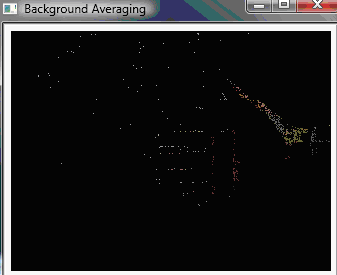OpenCV Tutorial 8 - Chapter 9
来源:互联网 发布:淘宝店营销策划书范文 编辑:程序博客网 时间:2024/04/28 21:52
Contact: nk752@drexel.edu
Keywords: OpenCV, computer vision, image processing, segmentation
My Vision Tutorials Index
This tutorial assumes the reader:
(1) Has a basic knowledge of Visual C++
(2) Has some familiarity with computer vision concepts
(3) Has read the previous tutorials in this series
The rest of the tutorial is presented as follows:
- Step 1: Background Averaging
- Step 2: Other Segmentation Functions
- Final Words
Important Note!
More information on the topics of these tutorials can be found in this book:Learning OpenCV: Computer Vision with the OpenCV Library
Step 1: Background Averaging(背景平均化)

Background averaging example(背景平均化示例)
The background averaging method of image segmentation computes the average difference between each image pixel and a model of the background(背景图像分割方法平均计算每个像素点和背景模型之间的平均差异). The background model is created by accumulating a set of frames and the difference between the current frame and the last frame withcvAcc and cvAbsDiff(背景模型的创建是通过积累一组帧和当前帧与最后一帧的区别,结合 cvAcc和cvAbsDiff). After the model is learned, a mask is created usingcvInRange and combining the channels with cvOr(据悉该模型后,面具使用cvInRange来创建,结合cvOr渠道). This example usesAllocateImages( IplImage* I ) to setup the images needed for scratch work,accumulateBackground( IplImage* I ) to build up model information, createModelfromStats() to build the background model,backgroundDiff( IplImage *I, IpleImage *Imask ) to calculate the difference between the current image and the model, and finallyDeallocateImages() to release the image objects used(这个例子使用AllocateImages( IplImage* I )来设置图像需要从头开始工作,用accumulateBackground( IplImage* I )来建立模型信息,用createModelfromStats()来建立背景模型,用backgroundDiff( IplImage *I, IpleImage *Imask )来计算当前图像与模型之间的差异,最后用DeallocateImages()来释放所使用的图像对象). Here is the code(以下是代码):
// Global storage
IplImage *IavgF, *IdiffF, *IprevF, *IhiF, *IlowF;
IplImage *Iscratch, *Iscratch2;
IplImage *Igray1, *Igray2, *Igray3;
IplImage *Ilow1, *Ilow2, *Ilow3;
IplImage *Ihi1, *Ihi2, *Ihi3;
IplImage *Imaskt;
float Icount;
// Function of allocating images
void AllocateImages( IplImage* I ){
CvSize sz = cvGetSize( I );
IavgF = cvCreateImage( sz, IPL_DEPTH_32F, 3 );
IdiffF = cvCreateImage( sz, IPL_DEPTH_32F, 3 );
IprevF = cvCreateImage( sz, IPL_DEPTH_32F, 3 );
IhiF = cvCreateImage( sz, IPL_DEPTH_32F, 3 );
IlowF = cvCreateImage( sz, IPL_DEPTH_32F, 3 );
Ilow1 = cvCreateImage( sz, IPL_DEPTH_32F, 1 );
Ilow2 = cvCreateImage( sz, IPL_DEPTH_32F, 1 );
Ilow3 = cvCreateImage( sz, IPL_DEPTH_32F, 1 );
Ihi1 = cvCreateImage( sz, IPL_DEPTH_32F, 1 );
Ihi2 = cvCreateImage( sz, IPL_DEPTH_32F, 1 );
Ihi3 = cvCreateImage( sz, IPL_DEPTH_32F, 1 );
cvZero( IavgF );
cvZero( IdiffF );
cvZero( IprevF );
cvZero( IhiF );
cvZero( IlowF );
Icount = 0.0001; // protect against divid by 0
Iscratch= cvCreateImage( sz, IPL_DEPTH_32F, 3 );
Iscratch2 = cvCreateImage( sz, IPL_DEPTH_32F, 3 );
Igray1 = cvCreateImage( sz, IPL_DEPTH_32F, 1 );
Igray2 = cvCreateImage( sz, IPL_DEPTH_32F, 1 );
Igray3 = cvCreateImage( sz, IPL_DEPTH_32F, 1 );
Imaskt = cvCreateImage( sz, IPL_DEPTH_8U, 1 );
cvZero( Iscratch );
cvZero( Iscratch2 );
}
// Learn the background statistics for one more frame
void accumulateBackground( IplImage *I ){
static int first = 1;
cvCvtScale( I, Iscratch, 1, 0 );
if( !first ){
cvAcc( Iscratch, IavgF );
cvAbsDiff( Iscratch, IprevF, Iscratch2 );
cvAcc( Iscratch2, IdiffF );
Icount += 1.0;
}
first = 0;
cvCopy( Iscratch, IprevF );
}
void setHighThreshold( float scale ) {
cvConvertScale( IdiffF, Iscratch, scale );
cvAdd( Iscratch, IavgF, IhiF );
cvSplit( IhiF, Ihi1, Ihi2, Ihi3, 0 );
}
void setLowThreshold( float scale ) {
cvConvertScale( IdiffF, Iscratch, scale );
cvAdd( Iscratch, IavgF, IlowF );
cvSplit( IlowF, Ilow1, Ilow2, Ilow3, 0 );
}
void createModelsfromStats(){
cvConvertScale( IavgF, IavgF, (double)(1.0/Icount) );
cvConvertScale( IdiffF, IdiffF, (double)(1.0/Icount) );
//Make sure diff is always something
cvAddS( IdiffF, cvScalar( 1.0, 1.0, 1.0), IdiffF );
setHighThreshold( 7.0 );
setLowThreshold( 6.0 );
}
// Create a mask
void backgroundDiff( IplImage *I, IplImage *Imask ){
cvCvtScale( I, Iscratch, 1, 0);
cvSplit( Iscratch, Igray1, Igray2, Igray3, 0 );
// channel 1
cvInRange( Igray1, Ilow1, Ihi1, Imask );
// channel 2
cvInRange( Igray2, Ilow2, Ihi2, Imaskt );
cvOr( Imask, Imaskt, Imask );
// channel 3
cvInRange( Igray3, Ilow3, Ihi3, Imaskt );
cvOr( Imask, Imaskt, Imask );
}
void DeallocateImages()
{
cvReleaseImage( &IavgF );
cvReleaseImage( &IdiffF );
cvReleaseImage( &IprevF );
cvReleaseImage( &IhiF );
cvReleaseImage( &IlowF );
cvReleaseImage( &Ilow1 );
cvReleaseImage( &Ilow2 );
cvReleaseImage( &Ilow3 );
cvReleaseImage( &Ihi1 );
cvReleaseImage( &Ihi2 );
cvReleaseImage( &Ihi3 );
cvReleaseImage( &Iscratch );
cvReleaseImage( &Iscratch2 );
cvReleaseImage( &Igray1 );
cvReleaseImage( &Igray2 );
cvReleaseImage( &Igray3 );
cvReleaseImage( &Imaskt );
}
int _tmain(int argc, _TCHAR* argv[])
{
cvNamedWindow( "Background Averaging", CV_WINDOW_AUTOSIZE );
CvCapture* capture = cvCreateFileCapture( "Averaging_Video.avi" );
IplImage *frame, *mask1, *mask3;
int frameCount = 0;
while(1) {
frameCount++;
frame = cvQueryFrame( capture );
if( !frame ) break;
CvSize sz = cvGetSize( frame );
mask1 = cvCreateImage( sz, IPL_DEPTH_8U, 1 );
mask3 = cvCreateImage( sz, IPL_DEPTH_8U, 3 );
if(frameCount == 1)
AllocateImages( frame );
if( frameCount < 30 ){
accumulateBackground( frame );
}else if( frameCount == 30 ){
createModelsfromStats();
}else{
backgroundDiff( frame, mask1 );
cvCvtColor(mask1,mask3,CV_GRAY2BGR);
cvNorm( mask3, mask3, CV_C, 0);
cvThreshold(mask3, mask3, 100, 1, CV_THRESH_BINARY);
cvMul( frame, mask3, frame, 1.0 );
cvShowImage( "Background Averaging", frame );
}
char c = cvWaitKey(33);
if( c == 27 ) break;
}
cvReleaseCapture( &capture );
cvDestroyWindow( "Background Averaging" );
DeallocateImages();
}
Step 2: Other Segmentation Functions(其他的分割功能)
I want to touch on more processing that can be done with segmentation, please see the text to understand how to implement these functions(我想谈谈更多可以用分割来完成的处理,请看这段文字,了解如何实现这些功能). Codebooks can be used to build a more complex model of the background, there is an example in the text(码本可以用来建立一个背景更复杂的模型,有一个在文本中的范例). There are other methods such as the watershed algorithm, that divides the image into "mountains" of edges seperating "plains" of more uniform areas(还有其他方法如分水岭算法,即 图象分为“山”的边缘分离“平地”的更均匀的区域). And there is also Delaunay Triangulation, a method for noting the relationship between feature points in order to track an object(此外,这里也有德洛内三角算法,该算法是注意到特征点之间的关系,以便跟踪对象). These methods and more are further examined in the text(这些方法和更多的将在文本作进一步研究).
Final Words(结束语)
This tutorial's objective was to show how to use some methods of segmentation(本教程的目标是展示如何使用分割的几种方法).
Click here to email me.
Click here to return to my Tutorials page.
- OpenCV Tutorial 8 - Chapter 9
- OpenCV Tutorial 9 - Chapter 10
- OpenCV Tutorial 7- Chapter 8
- OpenCV Tutorial 2 - Chapter 3
- OpenCV Tutorial 3 - Chapter 4
- OpenCV Tutorial 4 - Chapter 5
- OpenCV Tutorial 5 - Chapter 6
- OpenCV Tutorial 6 - Chapter 7
- OpenCV Tutorial 10 - Chapter 11
- OpenCV Tutorial 11 - Chapter 13
- OpenCV Tutorial: OpenCV介紹
- Microsoft Agent Tutorial Chapter 1
- Microsoft Agent Tutorial Chapter 2
- Microsoft Agent Tutorial Chapter 2
- Chapter 1 - A Tutorial Introduction
- OpenCV Tutorial roadmap
- OpenCV Tutorial (學習筆記)
- OpenCV Tutorial CVPR 2015
- 检索多个条件,个数不定时,数据库sql检索
- 马来西亚自助游攻略(第一天)
- Chapter 02 - Single-Table Queries
- Chapter 02 - Single-Table Queries - Exercises
- Chapter 02 - Single-Table Queries - Solutions
- OpenCV Tutorial 8 - Chapter 9
- oracle 11gR2 grid infrastructure无法识别ASM disks
- Chapter 03 - Joins
- Chapter 03 - Joins - Exercises
- OpenCV Tutorial 9 - Chapter 10
- Chapter 03 - Joins - Solutions
- 暑假集训总结 -- 持续更新
- Chapter 04 - Subqueries
- Chapter 04 - Subqueries - Exercises


